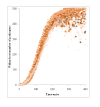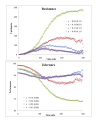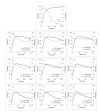Effectiveness analysis of resistance and tolerance to infection
- PMID: 21362170
- PMCID: PMC3066122
- DOI: 10.1186/1297-9686-43-9
Effectiveness analysis of resistance and tolerance to infection
Abstract
Background: Tolerance and resistance provide animals with two distinct strategies to fight infectious pathogens and may exhibit different evolutionary dynamics. However, few studies have investigated these mechanisms in the case of animal diseases under commercial constraints.
Methods: The paper proposes a method to simultaneously describe (1) the dynamics of transmission of a contagious pathogen between animals, (2) the growth and death of the pathogen within infected hosts and (3) the effects on their performances. The effectiveness of increasing individual levels of tolerance and resistance is evaluated by the number of infected animals and the performance at the population level.
Results: The model is applied to a particular set of parameters and different combinations of values. Given these imputed values, it is shown that higher levels of individual tolerance should be more effective than increased levels of resistance in commercial populations. As a practical example, a method is proposed to measure levels of animal tolerance to bovine mastitis.
Conclusions: The model provides a general framework and some tools to maximize health and performances of a population under infection. Limits and assumptions of the model are clearly identified so it can be improved for different epidemiological settings.
Figures





Similar articles
-
Genetic factors affecting susceptibility of dairy cows to udder pathogens.Vet Immunol Immunopathol. 2002 Sep 25;88(3-4):103-10. doi: 10.1016/s0165-2427(02)00138-1. Vet Immunol Immunopathol. 2002. PMID: 12127409 Review.
-
Mastitis associated transcriptomic disruptions in cattle.Vet Immunol Immunopathol. 2010 Dec 15;138(4):267-79. doi: 10.1016/j.vetimm.2010.10.005. Epub 2010 Oct 30. Vet Immunol Immunopathol. 2010. PMID: 21040982 Review.
-
Economic values and expected effect of selection index for pathogen-specific mastitis under Danish conditions.J Dairy Sci. 2010 Jan;93(1):358-69. doi: 10.3168/jds.2009-2506. J Dairy Sci. 2010. PMID: 20059934
-
A strain-, cow-, and herd-specific bio-economic simulation model of intramammary infections in dairy cattle herds.J Theor Biol. 2018 Jul 14;449:83-93. doi: 10.1016/j.jtbi.2018.04.022. Epub 2018 Apr 17. J Theor Biol. 2018. PMID: 29678690
-
Genetic analysis of pathogen-specific intramammary infections in dairy cows.J Dairy Sci. 2021 Feb;104(2):1982-1992. doi: 10.3168/jds.2020-19062. Epub 2020 Nov 25. J Dairy Sci. 2021. PMID: 33246624
Cited by
-
A mathematical model to study resistance and tolerance to infection at the animal and population levels: application to E. coli mastitis.Front Genet. 2012 Dec 14;3:146. doi: 10.3389/fgene.2012.00146. eCollection 2012. Front Genet. 2012. PMID: 23248637 Free PMC article.
-
Effect of feed restriction on performance and postprandial nutrient metabolism in pigs co-infected with Mycoplasma hyopneumoniae and swine influenza virus.PLoS One. 2014 Aug 7;9(8):e104605. doi: 10.1371/journal.pone.0104605. eCollection 2014. PLoS One. 2014. PMID: 25101681 Free PMC article.
-
Tolerance to Plant Pathogens: Theory and Experimental Evidence.Int J Mol Sci. 2018 Mar 11;19(3):810. doi: 10.3390/ijms19030810. Int J Mol Sci. 2018. PMID: 29534493 Free PMC article. Review.
-
The first step toward genetic selection for host tolerance to infectious pathogens: obtaining the tolerance phenotype through group estimates.Front Genet. 2012 Dec 14;3:265. doi: 10.3389/fgene.2012.00265. eCollection 2012. Front Genet. 2012. PMID: 23412990 Free PMC article.
-
Selection of pigs for improved coping with health and environmental challenges: breeding for resistance or tolerance?Front Genet. 2012 Dec 14;3:281. doi: 10.3389/fgene.2012.00281. eCollection 2012. Front Genet. 2012. PMID: 23248641 Free PMC article.
References
-
- Jovanović S, Savić M, Živković D. Genetic variation in disease resistance among farm animals. Biotech Anim Husbandry. 2009;25:339–347.
-
- Smith VH, Holt RD. Resource competition and within-host disease dynamics. Tree. 1996;11:386–389. - PubMed
Publication types
MeSH terms
LinkOut - more resources
Full Text Sources
Medical
Research Materials

